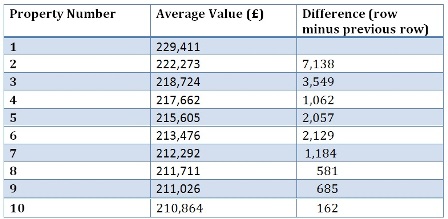An odd conclusion on house prices
Are odd-numbered houses really worth an average of £538 more than even-numbered ones?
That’s the claim made by Zoopla, the property website. It reached the conclusion by interrogating its database of property sales across the UK. The story was picked up by the Daily Mail.
What’s the explanation? Its table of values for the top ten (below) shows that houses with low numbers tend to fetch more than those with higher numbers. There are two possible reasons for this. Low-numbered houses tend to be nearer the city centre, and hence more desirable. Numbering generally runs outwards from urban centres.
But a much better reason, especially for the higher values of numbers 1 and 2, is that in terraced streets they are the end-of-terrace houses. They share only one wall with their neighbours, not two. There may be side access, room for a garage, and extra windows. End-of-terrace house attract a price premium. The same may be true to a lesser extent for semi-detached houses that lie at the end of the road.
Houses numbered 1 are invariably at the end of the street, those numbered 2 often are, but not always. In terraces that occupy only one side of a road, No 2 would be a mid-terrace house. So on average you would expect a greater premium for houses numbered 1 than those numbered 2, which is what the Zoopla data shows.
But does this extra premium for No 1 affect the overall results? You might expect that when all numbers are considered its effect would be swamped. No so, however, because if you calculate the differences in value between houses of increasing numbers, they rapidly tail off (see Table). Zoopla only provided data for the top ten, so I can’t prove this, but I suspect for numbers greater than 10 the differences in price are very small and essentially random – No 13 excluded, because some buyers are superstitious.

So the average difference calculated by Zoopla is dominated by the end-of-terrace phenomenon. If you exclude No 1 from the calculation, the average for odd-numbered houses in the top ten comes down to £214,411, while that for even-numbered houses is £215,197 – so even-numbered houses in this case are more, not less expensive.
But it’s a bit unfair calculating an average for such a short set of declining numbers – if you exclude both Nos 1 and 2, the average favours odd numbers (£213,911 odds, £213,428 evens).
However, my bet is that the figure claimed by Zoopla is simply a function of the fact that many people in the UK inhabit terraces, and that No 1 has a sufficient premium in price to dominate the rapidly diminishing difference as you go up the street.
However, if you do own an end-of-terrace house, the Zoopla data provides a nice index of how much more it might be worth than your neighbour’s.




Tim Jones (not verified) wrote,
Wed, 02/11/2011 - 15:32
And what about unnumbered, named houses? They're surprisingly silent on these...
Anonymous (not verified) wrote,
Thu, 03/11/2011 - 09:40
Surely as most streets have odd numbers on one side and an even number the other side, numbers 1 and 2 will both be end of terraces in terrace streets?
cl (not verified) wrote,
Thu, 03/11/2011 - 09:56
I would guess that roads with fewer houses tend to have larger, more expensive houses and the higher numbers can't appear in these.
Also, if you were building a development, you might put more resources into making the houses on the end more attractive.
Nigel Hawkes (not verified) wrote,
Thu, 03/11/2011 - 16:22
I dealt with the No 2 issue, though maybe not wholly cionvincingly. As for houses with names, Zoopla did show they they fetch more money, as many of them are larger, rural properties. I didn't mention it because it's hard to disagree with that conclusion
Anonymous (not verified) wrote,
Sat, 05/11/2011 - 17:56
I have read that east-west roads tend to be numbered from the left first, giving the odd numbered houses a south facing garden. Now, this doesn't fit with the idea of numbering houses from city centre outwards, but it is food for thought.
Maybe in the east of London even numbered houses are more likely to have a south facing garden, with west London houses having more odd numbered houses having south facing gardens. I can't say for certain how much difference this would make, but surely some!
One more point: on Zoopla, the house own says how much there house is worth.